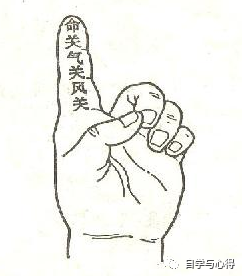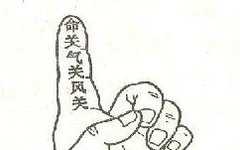Observation Diagnosis: Observing the Finger Meridian of Children
1. Methods and Normal Manifestations of Observing the Finger Meridian in Children
(1) Method of Observing the Finger Meridian in Children
Hold the child in a well-lit area. The practitioner uses the thumb and index finger of the left hand to grasp the tip of the child’s index finger. With the edge of the right thumb, gently push along the palmar side of the index finger from the fingertip towards the base several times, applying appropriate pressure to reveal the finger meridian for observation.
(2) Normal Manifestations of the Finger Meridian in Children
1. Characteristics of the Finger Meridian: It is subtly visible near the transverse lines of the index finger’s palmar side, with a light red to slightly purple color, appearing as a single branch of moderate thickness.
2. Influencing Factors: The visibility of the child’s finger meridian is affected by various factors.
(1) In younger children, the meridian is more prominent and longer; in older children, it is less visible and slightly shorter.
(2) In children with thin skin, the finger meridian is more visible; in those with thicker skin, it is often blurred and not apparent.
(3) In obese children, the meridian appears deeper and less visible; in lean children, it is shallower and more apparent.
(4) In hot weather, the meridian expands, becoming thicker and longer; in cold weather, it contracts, becoming thinner and shorter.
2. Clinical Manifestations and Significance of Pathological Changes in the Finger Meridian of Children
When observing the pathological finger meridian in children, attention should be paid to changes in the position, pattern, color, and shape of the lines, which can be summarized as: measuring severity through the three gates, distinguishing between superficial and deep, identifying cold and heat through color, and determining deficiency or excess through thickness.
1. Measuring Severity through the Three Gates
The child’s index finger is divided into three gates based on the finger joints: the first section (between the transverse line of the palm and the second joint) is the Wind Gate, the second section (between the second and third joints) is the Qi Gate; the third section (from the third joint to the fingertip) is the Life Gate. The position of the meridian in these three gates can indicate the depth of pathogenic factors and the severity of the condition.

(1) If the finger meridian is prominent in the Wind Gate: it indicates that the pathogenic factor has entered the meridian, is superficial, and the condition is mild, often seen in the early stages of external invasion.
(2) If the finger meridian reaches the Qi Gate: it indicates that the pathogenic factor has entered the channel, is deeper, and the condition is severe.
(3) If the finger meridian reaches the Life Gate: it indicates that the pathogenic factor has entered the organs, and the condition is serious.
(4) If the finger meridian extends to the fingertip (penetrating the gate and shooting the nail): it suggests a critical condition with a poor prognosis.
2. Distinguishing Between Superficial and Deep
(1) If the finger meridian is floating and prominent: it indicates that the pathogenic factor is superficial, often seen in external invasion. This is due to the external pathogen attacking the surface, with the righteous Qi resisting, causing the Qi and blood to rise to the surface, hence the finger meridian appears floating.
(2) If the finger meridian is stable and not prominent: it indicates that the pathogenic factor is internal, often seen in internal injury. This is due to the pathogenic Qi being trapped internally, obstructing the Qi and blood from reaching the surface, hence the finger meridian appears stable.
3. Identifying Cold and Heat through Color
Generally, if the color of the lines is deep and dark, it often indicates an excess condition, suggesting an abundance of pathogenic Qi; if the color is light and pale, it often indicates a deficiency condition, suggesting insufficient righteous Qi.
(1) If the finger meridian is bright red: it indicates an external invasion or cold condition. This is due to the struggle between the pathogenic and righteous Qi, causing the Qi and blood to rise to the surface, hence the finger meridian appears bright red. (This is a unique aspect of TCM diagnosis; generally, red indicates heat, but in the observation of the child’s finger meridian, red indicates a cold condition.)
(2) If the finger meridian is purple-red: it indicates an internal heat condition. This is due to internal heat being intense, causing the meridian to expand and the Qi and blood to stagnate, hence the purple-red appearance.
(3) If the finger meridian is blue: it indicates pain or convulsions. Pain leads to obstruction, or internal liver wind causes stagnation of the meridian, resulting in a blue-purple color.
(4) If the finger meridian is pale white: it indicates spleen deficiency or accumulation. The deficiency of spleen and stomach Qi leads to insufficient generation of Qi and blood to nourish the meridian, hence the pale white color.
(5) If the finger meridian is purple-black: it indicates blood stasis, suggesting a severe condition. Excessive pathogenic Qi, combined with heart and lung Qi deficiency, leads to obstruction of the meridian, hence the purple-black appearance.
4. Determining Deficiency or Excess through Thickness
(1) If the finger meridian is shallow and thin: it often indicates a deficiency condition.
(2) If the finger meridian is thick and stagnant: it often indicates an excess condition.

